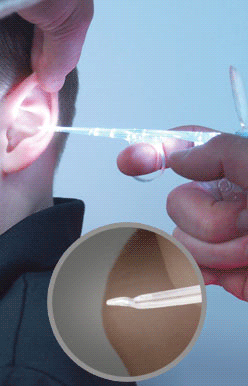The Bionix Lighted Articulating Ear Curettes are designed to make the process of removing ear and nasal obstructions safer, easier, and more effective. This unique curette integrates high-quality LED illumination and magnification into the body of the curette itself to eliminate the need for a third party. This allows the clinician to have a clear view of the ear canal or nasal passage while streamlining the entire examination and obstruction removal process, improving accuracy and efficiency of procedures while saving valuable time for medical facilities and professionals.
The unique 90-degree articulating tip allows the physician to work behind the obstruction, eliminating the top-down sweeping motion that can abrade the ear canal or push the obstruction further in, and allowing for an easy pulling motion to bring the object towards the clinician and out of the ear or nasal passage, saving time and reducing the risk of injury. Bright LEDs illuminate the entire ear canal or nasal passage for improved accuracy and convenience, shortening the procedure time and improving the patient's experience. The disposable construction reduces the risk of cross-contamination to maintain hygiene while reducing the costs associated with frequent sterilization of reusable products.
The illuminable design common to all of Bionix's Lighted Technology products coupled with the elegantly crafted articulating tip makes the Lighted Articulating Curette the full package when it comes to removing cerumen and foreign bodies from the patient's ear during medical procedure.
CAUTION: Discontinue curettage immediately if bleeding, irritation, or other trauma to the ear canal or tympanic membrane

Special Note:
The Lighted Articulating Ear Curette is intended for single-patient use. Discontinue use of the curette if the hinge no longer functions. Re-use of the curette can cause the hinge to stop functioning. Use of alcohol wipes or cold sterilization can also negatively affect the functioning of the curette. The light source and magnification lens are designed for multi-procedure use.
U
sing the Lighted Articulating Ear Curette
Position the patient comfortably on the examination table. Smaller children may be restrained on their parent’s lap or shoulder during the procedure. Visit www.BionixMed.com and view the Bionix Cerumen Removal Tips and Techniques videos for more detail.
Using an otoscope, examine the ear canal noting the presence and location of any obstructing cerumen or foreign body.
Straighten the ear canal by gently pulling the ear up and away from the patient. Position the tip of the Lighted Articulating Ear Curette adjacent to the obstruction or behind it if there is room between the obstruction and the ear canal wall.
Grasp the handle of the Lighted Articulating Curette in your palm placing your index finger in the trigger and gently pull back. This will cause the tip of the curette to bend.
Hold the tip in the flexed position and gently roll the obstruction from the ear canal.
Use an otoscope to re-examine the ear canal, noting the presence and location of any remaining obstruction.
Repeat the above procedure as needed to until the tympanic membrane can be adequately visualized, or the foreign body has been removed.
Remove the otoscope and discard the curette tip.
CAUTION: Discontinue curettage immediately if bleeding, irritation,
or other trauma to the ear canal or tympanic membrane occurs.
Instructions for Cerumen Removal
Using the Lighted Articulating Ear Curette
Position the patient comfortably on the examination table. Smaller children may be restrained on their parent’s lap or shoulder during the procedure. Visit www.BionixMed.com and view the Bionix Cerumen Removal Tips and Techniques videos for more detail.
Using an otoscope, examine the ear canal noting the presence and location of any obstructing cerumen or foreign body.
Straighten the ear canal by gently pulling the ear up and away from the patient. Position the tip of the Lighted Articulating Ear Curette adjacent to the obstruction or behind it if there is room between the obstruction and the ear canal wall.
Grasp the handle of the Lighted Articulating Curette in your palm placing your index finger in the trigger and gently pull back. This will cause the tip of the curette to bend.
Hold the tip in the flexed position and gently roll the obstruction from the ear canal.
Use an otoscope to re-examine the ear canal, noting the presence and location of any remaining obstruction.
Repeat the above procedure as needed to until the tympanic membrane can be adequately visualized, or the foreign body has been removed.
Remove the otoscope and discard the curette tip.
CAUTION: Discontinue curettage immediately if bleeding, irritation,
or other trauma to the ear canal or tympanic membrane occurs.
Instructions for Cerumen Removal
Using the Lighted Articulating Ear Curette
Position the patient comfortably on the examination table. Smaller children may be restrained on their parent’s lap or shoulder during the procedure. Visit www.BionixMed.com and view the Bionix Cerumen Removal Tips and Techniques videos for more detail.
Using an otoscope, examine the ear canal noting the presence and location of any obstructing cerumen or foreign body.
Straighten the ear canal by gently pulling the ear up and away from the patient. Position the tip of the Lighted Articulating Ear Curette adjacent to the obstruction or behind it if there is room between the obstruction and the ear canal wall.
Grasp the handle of the Lighted Articulating Curette in your palm placing your index finger in the trigger and gently pull back. This will cause the tip of the curette to bend.
Hold the tip in the flexed position and gently roll the obstruction from the ear canal.
Use an otoscope to re-examine the ear canal, noting the presence and location of any remaining obstruction.
Repeat the above procedure as needed to until the tympanic membrane can be adequately visualized, or the foreign body has been removed.
Remove the otoscope and discard the curette tip.
CAUTION: Discontinue curettage immediately if bleeding, irritation,
or other trauma to the ear canal or tympanic membrane occurs














